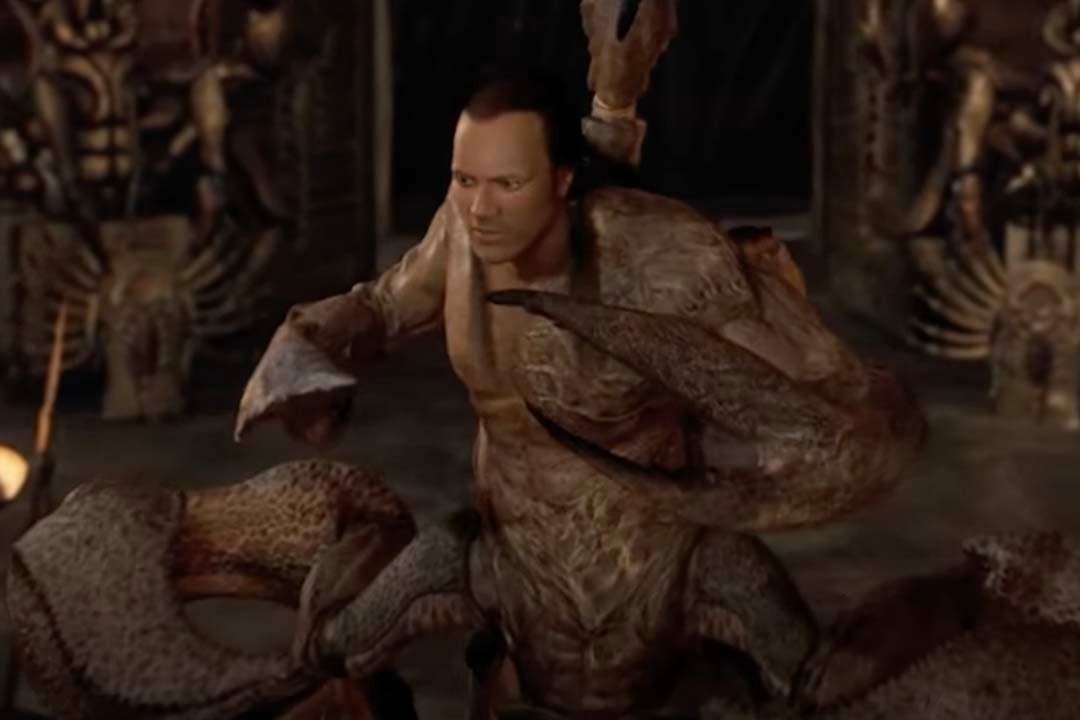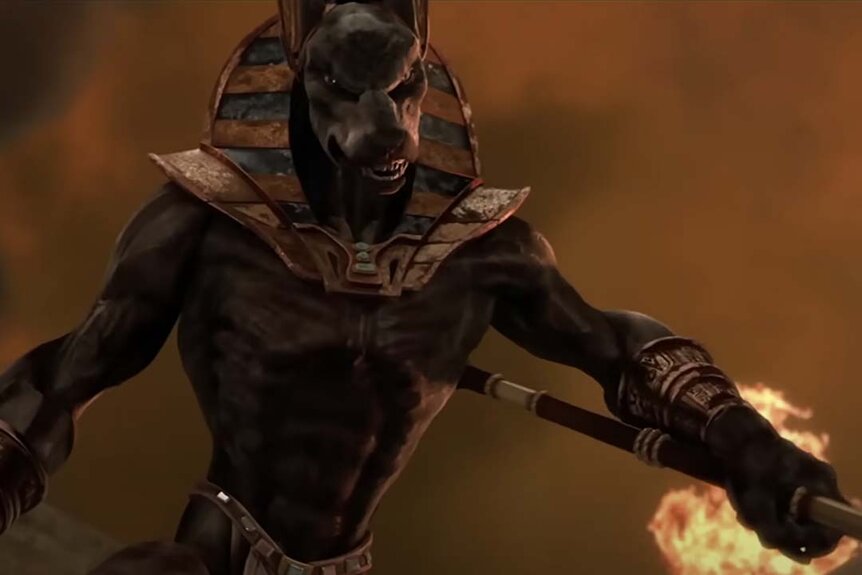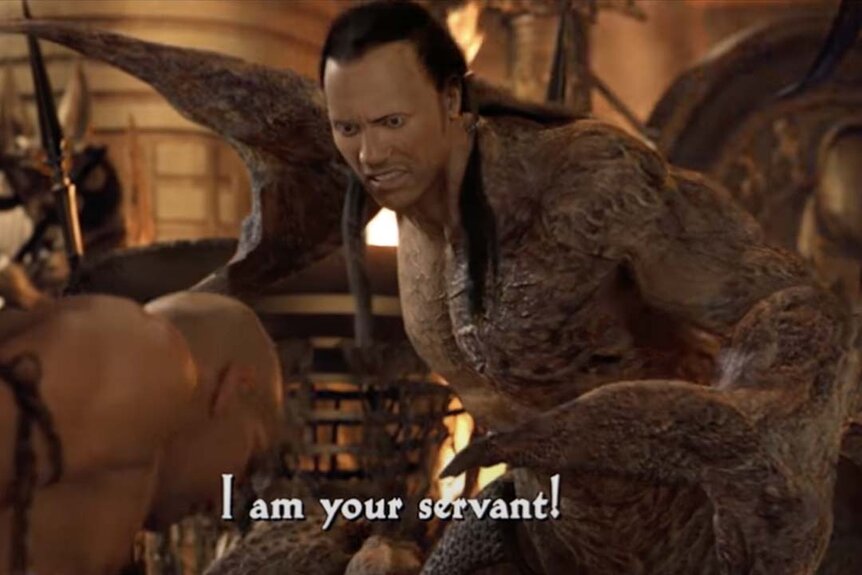Create a free profile to get unlimited access to exclusive videos, sweepstakes, and more!
Understanding the Uncanny Valley with The Mummy Returns
The Mummy Returns' Scorpion King looks pretty weird, and part of that is the uncanny valley.

Following the breakout success of The Mummy in 1999, a sequel went into production pretty much immediately. The Mummy Returns (streaming now on Peacock!) sees the return of familiar characters Rick O’Connell, Evelyn O’Connell, and Imhotep, while also introducing new characters including Dwayne "The Rock" Johnson's Mathayus of Akkad, also known as the Scorpion King.
The movie hit theaters in 2001, while visual effects technologies were undergoing a period of rapid evolution. There were some understandable growing pains during the adolescence of digital visual effects, but it’s harder to come up with a more egregious example than the Rock-scorpion hybrid at the end of The Mummy Returns. It was clear, even at the time, that something had gone wrong, and hindsight gives us a little clarity on why the first outing of the Scorpion King was horrifying in all the wrong ways.
The Mummy Returns and the Uncanny Valley
The first challenge worth mentioning is logistical rather than technical. During production, the visual effects team didn’t have the visual references they needed to create a compelling digital representation of Johnson. Because of schedule limitations, they weren’t able to photograph the fine details of his face to ensure a more accurate recreation. So, what we ended up with was sort of like the digital equivalent of trying to draw a person’s face from memory.
RELATED: 'The Mummy' Director Stephen Sommers Muses On What a Future Sequel Might Look Like
While that almost certainly made the job harder than it might have been, the effects team was also up against a psychological barrier we still don’t totally understand. They made some wrong turns and stumbled face first into the uncanny valley.
Roboticist Masahiro Mori coined the term “uncanny valley” in 1970 as a way of describing the sometimes viscerally negative reactions people have to humanoid robots. It’s often presented in a graph with human likeness on the x axis and affinity on the y axis. Then, you can take any non-human thing you like and plot where it belongs on the graph. You’ll quickly see that something weird happens when you look at objects that are pretending to be human (or human-like) but aren’t.
Take, for example, a stuffed animal. It’s obviously trying to look like something alive, maybe even something vaguely anthropomorphic, but our brains immediately recognize that it’s a facsimile. A stuffed animal doesn’t set off any alarm bells and, in fact, can make us feel quite nice. But turn that stuffie into a doll and make it look like a baby and suddenly things are a little bit less comfortable. Make that baby increasingly realistic and people start to like it less and less. It’s the same reason many people who wear prosthetics prefer artificial limbs which are obviously artificial.
Why Some Robots and Animations Look Uncanny
We’re not quite sure why the uncanny valley phenomenon occurs but it might have something to do with a gap in expectations. When we see something that’s obviously non-human, we’re more willing to accept unusual behavior or an unexpected appearance. But once you push the “possibly human” button in our brains we start to scrutinize things a lot more seriously.
Being human (or human-like) comes with a set of subtle, subconscious rules and if a thing doesn’t match up to those expectations our alarm bells start ringing. As digital tools became available it was inevitable that we’d run into the intersection of our brains’ requirements and our technology’s limitations. Certainly, The Mummy Returns wasn’t the only casualty of our early expeditions into the uncanny valley. Pixar also learned the dangers of animating human faces the hard way in an early short film called Tin Toy.
RELATED: Did an AI Lie About Rebelling Against Humans at Geneva AI Summit?
Viewers liked the titular tin toy just fine, but they had other thoughts about the short film’s other main character: a human baby. One critic called the short perhaps “the most frightening piece of animation in the existence of the art form.” Interestingly, there are shots which work perfectly fine. The backgrounds are a little flat but many of the toys and other objects are pretty well animated even by today’s sensibilities. The baby, however, is horrifying. And unfortunately, it features heavily.
Almost everything about the baby below the neck is acceptable, especially when it’s sitting still, but the face is awful. When it chases the tin toy you can almost feel genuine fear as the tiny metal man flees for its life from this comparatively gigantic monstrosity. Pixar seemingly learned its lesson from that early outing; what few human characters show up in later films have a more stylized appearance, deftly avoiding the valley.
It’s hard to say why poorly animated people bother us so much, but it might be that we’ve been finely honed by millions of years of evolution to look for minute changes in the appearance of our peers. Small fluctuations in the face signal everything from fear to love, and understanding those nonverbal communications is crucial to our survival and the functioning of our societies even today.
Even if we can’t articulate it, we know what a person is supposed to look like, and it’s exceedingly difficult to replicate artificially. The Mummy Returns tried to thread a narrow psychological needle and bumped up against the limits of the eye.
The moment begins with the cracking of a door. Both Rick and Imhotep freeze, temporarily pausing their deadly combat, and stand in fear and wonder as the Scorpion King emerges. Through the shadows, we see a monstrous combination of chitinous, clawed body and Dwayne Johnson’s hulking body. Even before he comes completely out of the shadows, you know something is off. The face isn’t right and there’s no life behind the eyes.
The thing is, if you put your thumb over the face it looks pretty good. About 80% of the creature is convincing enough to pass onscreen, and that shouldn’t be surprising. The first film and much of the second features a lot of really fun visual effects, many of which are totally digital. If The Mummy Returns had featured just a giant scorpion with the same level of quality, it never would have taken the level of criticism it did. But there’s a higher bar — maybe even an impossibly high bar — when animating people. Even if those people are cursed arachnids.
Catch The Mummy, The Mummy Returns, and The Mummy: Tomb of the Dragon Emperor streaming now on Peacock!




























